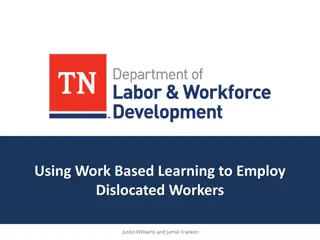Impact of COVID on Apprenticeships: Lessons from Australia and Beyond
This presentation by Professor Erica Smith explores the effects of COVID and post-COVID measures on apprenticeships, focusing on Australia's system while offering insights from other countries. It delves into the challenges faced, diversity issues, profiteering concerns, and the implications for the future of apprenticeship programs. The unique characteristics of each country's apprenticeship system are highlighted, emphasizing the need for tailored approaches to address economic, social, and stakeholder dynamics.
Download Presentation

Please find below an Image/Link to download the presentation.
The content on the website is provided AS IS for your information and personal use only. It may not be sold, licensed, or shared on other websites without obtaining consent from the author.If you encounter any issues during the download, it is possible that the publisher has removed the file from their server.
You are allowed to download the files provided on this website for personal or commercial use, subject to the condition that they are used lawfully. All files are the property of their respective owners.
The content on the website is provided AS IS for your information and personal use only. It may not be sold, licensed, or shared on other websites without obtaining consent from the author.
E N D
Presentation Transcript
Rescue and recovery: The effects of COVID and post-COVID measures on apprenticeships Professor Erica Smith Federation University Australia and Co-Chair, INAP apprenticeship network UALL/SCUTREA conference, Oxford, 26-28 June 2023
This presentation An overview of the Australian apprenticeship system. A summary of COVID apprenticeship measures in Australia and four other countries. The issues of concern in 2020 and now. The significance of the apprenticeship measures including diversity issues. Profiteering from COVID. The implications and possibilities for the future.
Health warning: Every country differs! In an overview report for a series of landmark documents on apprenticeship for Australia s National Centre for Vocational Education Research (2022), I wrote: Tolstoy s novel Anna Karenina (1873) begins with the following famous quote: All happy families are alike; each unhappy family is unhappy in its own way. Similarly, every country aims at the same happy outcomes for its apprenticeship system: skilled workers for industry, a labour force matching that needed by the economy, contented and competent workers, and a structure for young people to move from school into work. But every country has problems with its apprenticeship system that are unique to that country because of economic and social factors and power struggles among stakeholders. This holds true for COVID and post-COVID measures. This paper focuses on Australia and provides examples from some other countries. Your country might be quite different!
Australia: Two tiers of government (2016 statistics) 2016 statistics) Population: 23,401,892. (25.7m in 2021) 66% live in the eight capital cities. Percentage born overseas: 33.3%. Percentage indigenous: 2.8% (Aboriginal and Torres Strait Islander peoples). Working population: 11,471,296 (62% worked 35 hrs+ per week) . Top industries of employment: health, retail, hospitality, education, aged care.
Apprenticeships: A two-track system Traditional apprenticeships Mainly in manufacturing and construction. Predominantly male apart from hairdressing. 3-4 years term. Strong trade union influence. Generally dual training on the job and training provider. Traineeships Introduced from 1985. In retail, business, IT, community services, health etc. Mixed gender, with slightly more women. 1-2 years term. Also generally dual training on the job and training provider.
Apprentice system overview Share of the workforce in apprenticeship pre-COVID: 2.17%. This had fallen from a high of 4.10% in 2011 (underlying figure of around 3.7%) due to policy and funding changes (Smith, 2021). Apprentices and trainees are awarded VET (vocational education and training) qualifications, based on national competency standards contained in Training Packages . Apprentices and trainees are employed and are paid, sometimes a little less than a comparable worker of the relevant age (industry-specific and government regulations apply). State and Territory governments (of which there are eight) fund the off-the-job training and maintain registers of apprentice contracts. The Federal government provides commencement and completion incentive payments for employers plus extra subsidies for identified skills need industries and equity groups; and minor funding for apprentices/trainees themselves (e.g. living away from home allowance). Approximately 10% of apprentices and trainees are employed by Group Training Organisations . (different from English Group Training Companies more like Apprenticeship Training Agencies) (Smith, 2019) Diversity Gender: Men predominate. From 2001 to 2012, females moved nearer to men but the numbers of women in training even then were only about one-third of the total; since 2012 the gender gap has widened again. Females lag less in commencements, as women are more likely to be in shorter traineeships. Age: Open to adults as well as young people. Only one-third are 19 years and younger. Minority representation: Data are not readily available. Government measures apply for some minority groups such as indigenous people. Many companies and organisations also have measures in place.
Apprenticeship areas in Australia compared with England Top five apprenticeship commencement areas in Australia & England, 2018 figures % of all starts % of all starts Australia England Community and personal service workers Business, administration and law 17.49% 30.28% Construction trades workers Health, public services and care 13.84% 24.94% Engineering and manufacturing technologies Automotive and engineering trades workers 11.53% 15.27% Clerical and administrative workers Retail and commercial enterprise 11.04% 12.98% Machinery operators and drivers Construction, planning and the built environment 9.50% 5.85% Proportion of apprentice starts in top five subject areas Proportion of apprentice starts in top five subject areas 63.40% 89.31%
Numbers and gender composition, past 25 years, showing rapid decline from 2012-2015 (Smith, 2021). Apprentice contracts, commencements 1995-2019 by gender 200.0 175.0 150.0 Contracts ('000) 125.0 100.0 75.0 50.0 25.0 0.0 1995 1996 1997 1998 1999 2000 2001 2002 2003 2004 2005 Males 2006 2007 2008 2009 2010 2011 2012 2013 2014 2015 2016 2017 2018 2019 Females Years
Continued decline in starts from 2015 up to COVID outbreak (AATIS, 2021) Australian Apprenticeships Statistics Annual 2015 to 2019 200000 300000 180000 250000 160000 140000 200000 120000 100000 150000 80000 100000 60000 40000 50000 20000 0 0 2015 2016 2017 2018 2019 Commencements In-training (RHS)
Rescuing apprentice numbers in Australia 2020 apprentice starts were the lowest since 1997, at 118,000. But this was not actually very much lower than the late 2010s figures (see previous slide). By 2022 figures were up to 264,000 commencements, the highest numbers since 2012. How did this happen?
COVID measures: Australian Federal government The main concern was the preservation of apprenticeship jobs, but also with the maintenance of off-the-job training from the VET system (c.f. OECD, 2020). An Apprentice and Trainee Re-Engagement Register connected displaced apprentices with employers; The Supporting Apprentices and Trainees (SAT) initiative enabled small enterprises to receive a 50% wage subsidy when retaining a displaced apprentice or trainee, or employing a displaced one. From October 2020, Boosting Apprenticeship Commencements (BAC) program for all new starts (50% wage subsidy for the first year) https://www.dewr.gov.au/boosting-apprenticeship-commencement. Note: Wage subsidies had not previously been provided for apprentices wages. Group Training Organisations via the National Apprentice Employment Network (NAEN) peak body were heavily involved in the COVID initiatives. Some issues: It was reported at the time that the new initiatives sometimes lessened the appeal of the specific targeted funding for equity groups. From 2021, there were high vacancy rates in many job areas such as hospitality. Employers were looking for young applicants but they were not always coming forward, possibly due to higher unemployment benefits during COVID.
Example of a State governments initiatives: Victoria A new authority Apprenticeships Victoria was established in December 2020 as part of the State government. Its office was located in the CBD of Melbourne (capital city) so that the public could call in. Victoria s Big Build infrastructure and construction program had a strong apprenticeship focus https://www.vic.gov.au/big-build-apprenticeships-bba / $12m was provided to TAFE Institutes (the public TVET provider) in 2021 exclusively for apprenticeship and traineeship equipment. The apprenticeship and traineeship strategy included: Continued funding for Apprenticeship Support officers (based in TAFE Institutes public FE providers) Continued funding to support Victorian Group Training Organisations New Apprenticeship Innovation Funding for specified projects including encouraging more women into apprenticeships traditionally undertaken by men. Victoria also had its own COVID advice portal for apprentices and trainees.
Examples from other countries: INAP authors The following five slides are taken from the online 2021 INAP conference The State of Apprenticeship during the COVID-19 Pandemic: Reports from Seven Countries (International Network on Innovative Apprenticeship) (see https://www.urban.org/events/state-apprenticeship-during- covid-19-pandemic-reports-seven-countries) Some countries e.g. Switzerland (Gonon, 2021) did not experience much decline in apprenticeship numbers. (Many contextual factors could explain this) Two sets of concerns in most countries: o Effects of the pandemic on college teaching (if apprenticeships have an off-the-job component). o Apprentices in workplaces.
China: Short-run Responses on internship (Chinese term for work placements in apprenticeship) (Zhao, 2021) Concerns about safety were reason that hinders students from participating in internships; access to safety was also the most important requirement of interns Due to the shortage of labor during the epidemic, internships promoted the resumption of production of enterprises, enterprises opened more opportunities for VET students Insufficient professional competence was the main factor restricting the percentage of Major [subjects] - Job matching, which is consistent with the research before the epidemic Under the premise of effective epidemic prevention measures, small-scale, sporadic outbreaks (such as a local epidemic in Beijing, in Kashgar, Xinjiang) did not affect the resumption of production and internships Safety measures such as health monitoring, body temperature checking will exist as routine work 14
China: Short-run Responses on VET College Teaching (Zhao, 2021) People have realized the importance of online training and the deficiency of the corresponding competencies: Self-learning ability of students is poor Practical content cannot be taught online Availability of online teaching platforms is not satisfactory Teachers lack of online teaching capability Teaching effect is difficult to evaluate Insufficient online teaching resources People started to discuss how to realize different teaching content through diversified online methods 15
Canada: Effects of the pandemic (Watt 2021) 1 April 2019 to April 2020: -71% decrease in registrations. Fewer registrations: -43.0% (February to September 2020 compared to similar in 2019) Fewer certifications (i.e., completions): -47.7% (February to September 2020 compared to similar in 2019) Certifications at the lowest in June 2020: -76% Notes: Financial support fluctuated depending on province, territory and federal goals. Federal Budget 2021 allocated funding for apprenticeships.2,3 Apprenticeship system frameworks determined by provinces and territories. Occupational standards regulated by provinces and territories. Workforce varies by province and territory. 1Statistics Canada. (2021). Apprenticeship in Canada, 2019. https://www.statcan.gc.ca 2Gismondi, A. (2021). Federal budget provides funding for new apprenticeship service, supports skilled trades. https://canada.constructconnect.com 3Government of Canada. (2021). Budget 2021 job creation. https://www.canada.ca 16
Germany (Deissinger, 2021) Lowest number of new training contracts in the dual system since 1975. In 2020, training places offered fell to 527,400 (commencements declined by 8.8% from 2019, and numbers in-training fell by 11%). Schooling was insufficient due to COVID-related distance learning. Germany was unprepared for digital learning. Withdrawal of companies from training in a number of occupational fields due to the general economic situation, above all in very small companies. Matching problems in the training market and competition between different groups of school leavers in a number of occupational fields had increased. At the same time, higher education became more attractive for school leavers against the background of insecure prospects of the economy. Digitalisation now a major topic of VET policy through programmes such as JOBSTARTER, above all with respect to SME.s Government programmes included Maintaining Training Places (June 2020) were introduced to support companies in order to keep them in the training system (500m was available in the year 2021), e.g. through training allowances Sources: BMBF 2021; Jobstarter 2020; Eckelt at al. 2020 21-22.03.2019 17
Problems affecting employers of apprentices and apprentices/would-be apprentices (Germany) (Deissinger, 2021) Employers Apprentices/would be apprentices Some industries were more affected by COVID than others (e.g. hotels, restaurants, small retail premises) Young people were affected by mismatches in the training market. Especially, small companies in rural regions had stopped their training activities. Apprentices needed to atetnd work for their on-the-job training unless the company was closed or had restricted access due to COVID 19 or unless apprentices had been put under quarantine. Generally difficult learning conditions in the vocational schools due to lockdown(s). Surveys revealed concerns among young people about their careers and working lives. Low-income families and migrants seemed to be the major losers of the pandemic. Marketing for companies was difficult due to the cancellation of training fairs , etc. Recruitment practices turned digital. Formally, young people could not be easily transferred to short-time work - the training had to be carried out on the basis of the VTA training regulations Companies reported report shifting of examinations, and non-normal training practices due to the pandemic (50% and 36% respectively)
Finally, English measures relating to end-point assessments for apprenticeships The government agreed several flexibilities, including the following which have been retained. These were: Observations taking place in simulated environments Remote delivery of assessment (including invigilation) Pauses being allowed between assessment methods during end-point assessment period Assessments taking place outside of usual venues Delivery of assessment methods in any order (when a specified order is in the assessment plan) Exams/tests being online instead of on paper (where originally specified as paper based only) Gateway sign off being done remotely (where originally specified as having to be face to face) (Note: this information was current at February 2023)
Worries for apprenticeships post-COVID: those imagined in early COVID, and in 2023 Imagined at the time Mid-2023 concerns Massive rise in youth unemployment (Hurley, 2020). Lack of skilled labour because of apprentices not completing. Completing apprentices not able to get permanent jobs. Inability to provide or access training online. Providing workplace components during lockdown. Labour shortages. Unequal shortages among industries and occupations. Mental health issues among young people. Continued need for upskilling VET teachers for digital delivery, and for equity measures for digital training. Need to plan for future major disruptions.
Emphasis on youth employment Emphasis on skill development for companies Maintaining the balance of Maintaining the balance of apprenticeship apprenticeship (Smith, 2018, at an I.L.O. event) Youth employment My question then was: Example of youth employment: If apprenticeship is changed to primarily combat youth unemployment, would the other goals be compromised? Enterprise skill formation National skill development Training for innovation No, I didn t know COVID was coming! Inclusivity
What, then, is significant about COVID? The early and gloomy predictions were perhaps unaware of the way in which governments have always used apprenticeship systems as labour market tools and as social intervention points for young people. This is exactly what happened in the pandemic. Apprenticeship rescue measures were designed not just to rescue apprenticeships, but to rescue the whole economy by creating more jobs, in a way that was easy and defensible for governments to administer. Yet apprenticeship rescue measures persisted well into the recovery stage in some countries, including Australia. For example, wage subsidies for commencing apprentices carried on until 2022. Moreover, some government spending designed to create jobs and boost the economy more generally had disproportionate effects on apprenticeships; for example the State of Victoria s Big Build initiative provided large numbers of new apprenticeships in construction and civil construction.
The dark side: Making a buck from COVID COVID measures exacerbated existing problems in apprentice systems, including marketisation of apprentice functions. Disaster capitalism was alive and well in Australian apprenticeships: Australia uses private intermediary organisations ( ASNs ) acting as brokers to sign up apprentices. I predicted that the Boosting Apprenticeship Commencements 50% wage subsidies would lead to windfall profits for these organisations. In the end I was wrong but only in my prediction of who would rort the system: Some employers signed up cohorts of existing workers to management apprenticeships, leading to anomalous numbers of apprentices in higher level qualifications By early 2021 (swiftly!) the government closed the loophole, tightening the numbers and types of existing workers for whom companies could claim the subsidy. Unofficially I was told that it was private training providers who were encouraging employers to access the wage subsidies.
Post-pandemic apprenticeship prospects - Australia By 2023, most special employment support pandemic measures had ceased, as had the extra unemployment benefit. Uniquely, apprenticeship support has continued with the Boosting Apprenticeships Commencements scheme extended to 2022, and a new Completing Apprenticeship Commencements (CAC) scheme providing wage subsidies for continuing apprentices (i.e. in second and third years) and claims can be made until 2025. This benefits traditional apprenticeships, primarily undertaken by males. As the then Minister (Liberal i.e. conservative) said at an apprenticeship conference which I attended in March 2022, in light of the experience with wage subsidies, we need to think about their use and how big they should be. There were winners and losers, as Deissinger says about Germany. By gender, men were the big winners, especially in Victoria. Feminised industries were losers (retail, hairdressing, etc). Industries typically employing migrants and overseas students were losers. In Australia, the public and policy gaze has been averted from the issues caused by the previous decade s contraction of the systems, particularly in apprenticeships. This topic needs urgent attention. As the then Shadow Minister (Labor) said at the same conference, are the social partners willing to work together on the rebuilding of the system? PhillipsKPA said in a wide-ranging review of Australia s apprenticeship system in 2018: Stakeholders hold stridently divergent views, often protecting what might be described as an entrenched stakeholder interest the apprenticeship system is becoming ossified (and) these entrenched interests are effectively built into elements of regulation and system governance.
Opportunity or challenge: Some more fundamental questions Could the long-term decline in apprenticeship numbers in several countries (Smith, 2022) be reversed? Might employers who were attracted to apprenticeships by generous wage subsidies decide to stay within the system in the longer term? Might the temporary truce that happened among the tripartite partners and other stakeholder groups during COVID be extended? Could people who were attracted to apprenticeships, because such jobs were available, decide they want to stay with apprenticeships, and even encourage their peers and family members into the system? The participation of women in the system will it be confined to trying to get women into masculinised occupations? It seems certain that policy and academic debates on apprenticeships will be reframed for at least the medium term. And, we need labour and unions to work together as they did during the pandemic. As the PhillipsKPA report said in 2018: a substantial effort will be required to reach a new settlement between the various social parties to modernise aspects of the apprenticeships system and make them fit for purpose into the future.
Acknowledgements and contact details Acknowledgements: Thank you to the following people who spoke to me and/or sent information: Dianne Dayhew, CEO of National Apprenticeships Employment Network . Carl Walsh, Acting Director Apprenticeships Victoria, Victorian State Government. Peta Skujins, AATIS (Australian Apprenticeships & Traineeships Information Service). Chris Ratcliffe & Kim Budgen, National Careers Institute. Angela Tidmarsh, Dept of Education, Skills & Employment In England: Tom Bewick, Federation of Awarding Bodies; Richard Marsh. Contact information: Erica Smith e.smith@federation.edu.au Web site https://federation.edu.au/schools/school-of-education/staff- profiles/staff/Erica-Smith Research group Researching Adult and Vocational Education (RAVE) web site: https://federation.edu.au/schools/school-of-education/staff- profiles/staff/Erica-Smith More information on VET and COVID In Australia, the National Centre for Vocational Education Research (NCVER) has published several reports on VET and COVID. Access via: References: Smith, E. (2019). Intermediary organizations in apprenticeship systems. Geneva: International Labour Organization. Smith, E. (2021). The expansion and contraction of the apprenticeship system in Australia, 1985-2020. Journal of VET.73:2, 336-365. www.ncver.edu.au/research-and-statistics/publications/all- publications/delivery-of-vet-emerging-trends-in-response-to-the-covid-19- pandemic PhillipsKPA (2018). Apprenticeships Post 2020: National Apprenticeship Forums 2017-18. Draft report May 2018. Hawthorn, Vic: Phillips KPA.























